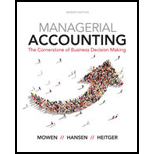
Concept explainers
1.
Calculate the
1.
Explanation of Solution
Profitability Ratio:
These ratios evaluate a firm’s ability to earn profits. They help the stakeholders of the company to measure the degree to which funds invested by them are efficiently used. Some of the ratios calculated return on sales, total assets and
Use the following formula to calculate the value of accounts receivable turnover in times for year 20X2:
Substitute $500,000 for net sales and $100,000 for average receivable in the above formula.
Therefore, the value of accounts receivable turnover in times is 5 times.
Use the following formula to calculate the value of accounts receivable turnover in days for year 20X2:
Substitute 365 days for days in a year and 5.00 times for average accounts receivable turnover in days in the above formula.
Therefore, the value of accounts receivable turnover in days is 73.00 days.
Use the following formula to calculate the value of accounts receivable turnover in times for year 20X3:
Substitute $600,000 for net sales and $110,000 for average receivable in the above formula.
Therefore, the value of accounts receivable turnover in times is 5.45 times.
Use the following formula to calculate the value of accounts receivable turnover in days for year 20X3:
Substitute 365 days for days in a year and 5.45 times for average accounts receivable turnover in days in the above formula.
Therefore, the value of accounts receivable turnover in days is 66.97 days.
Use the following formula to calculate the value of accounts receivable turnover in times for year 20X4:
Substitute $510,000 for net sales and $110,000 for average receivable in the above formula.
Therefore, the value of accounts receivable turnover in times is 4.64 times.
Use the following formula to calculate the value of accounts receivable turnover in days for year 20X4:
Substitute 365 days for days in a year and 4.64 times for average accounts receivable turnover in days in the above formula.
Therefore, the value of accounts receivable turnover in days is 78.66 days.
Use the following formula to calculate the value of accounts receivable turnover in times for year 20X5:
Substitute $510,000 for net sales and $125,000 for average receivable in the above formula.
Therefore, the value of accounts receivable turnover in times is 4.08 times.
Use the following formula to calculate the value of accounts receivable turnover in days for year 20X5:
Substitute 365 days for days in a year and 4.08 times for average accounts receivable turnover in days in the above formula.
Therefore, the value of accounts receivable turnover in days is 89.46 days.
Use the following formula to calculate the value of accounts receivable turnover in times for year 20X6:
Substitute $520,000 for net sales and $170,000 for average receivable in the above formula.
Therefore, the value of accounts receivable turnover in times is 3.06 times.
Use the following formula to calculate the value of accounts receivable turnover in days for year 20X6:
Substitute 365 days for days in a year and 3.06 times for average accounts receivable turnover in days in the above formula.
Therefore, the value of accounts receivable turnover in days is 119.28 days.
Working Note:
1. Calculation of average receivable:
2. Calculation of average receivable:
3. Calculation of average receivable:
4. Calculation of average receivable:
5. Calculation of average receivable:
2.
Explain the effect of the new credit policy with the help of above calculations.
2.
Explanation of Solution
Accounts receivable turnover decreased due to new credit policy because customers have 60 days to make full payment. As a result, it reduced the inflow of cash in the company. It also led to a shortage of cash due to which the company is unable to meet its short term requirements.
3.
Identify whether TP would have liberalized his company’s credit policy if it was known that industrial average was 6 times.
3.
Explanation of Solution
TP would not have liberalized the company’s credit policy if industrial average was known as accounts receivable turnover was already low as compared to the industry average.
Want to see more full solutions like this?
Chapter 15 Solutions
Bundle: Managerial Accounting: The Cornerstone of Business Decision-Making, Loose-Leaf Version, 7th + CengageNOWv2, 1 term (6 months) Printed Access Card
- I want to correct answer general accounting questionarrow_forwardQuick answer of this accounting questionsarrow_forwardMead Incorporated began operations in Year 1. Following is a series of transactions and events involving its long-term debt investments in available-for-sale securities. Year 1 January 20 Purchased Johnson & Johnson bonds for $20,500. February 9 Purchased Sony notes for $55,440. June 12 Purchased Mattel bonds for $40,500. December 31 Fair values for debt in the portfolio are Johnson & Johnson, $21,500; Sony, $52,500; and Mattel, $46,350. Year 2 April 15 Sold all of the Johnson & Johnson bonds for $23,500. July 5 Sold all of the Mattel bonds for $35,850. July 22 Purchased Sara Lee notes for $13,500. August 19 Purchased Kodak bonds for $15,300. December 31 Fair values for debt in the portfolio are Kodak, $17,325; Sara Lee, $12,000; and Sony, $60,000. Year 3 February 27 Purchased Microsoft bonds for $160,800. June 21 Sold all of the Sony notes for $57,600. June 30 Purchased Black & Decker bonds for $50,400. August 3 Sold all of the Sara…arrow_forward
 College Accounting, Chapters 1-27AccountingISBN:9781337794756Author:HEINTZ, James A.Publisher:Cengage Learning,
College Accounting, Chapters 1-27AccountingISBN:9781337794756Author:HEINTZ, James A.Publisher:Cengage Learning, Intermediate Financial Management (MindTap Course...FinanceISBN:9781337395083Author:Eugene F. Brigham, Phillip R. DavesPublisher:Cengage Learning
Intermediate Financial Management (MindTap Course...FinanceISBN:9781337395083Author:Eugene F. Brigham, Phillip R. DavesPublisher:Cengage Learning EBK CONTEMPORARY FINANCIAL MANAGEMENTFinanceISBN:9781337514835Author:MOYERPublisher:CENGAGE LEARNING - CONSIGNMENT
EBK CONTEMPORARY FINANCIAL MANAGEMENTFinanceISBN:9781337514835Author:MOYERPublisher:CENGAGE LEARNING - CONSIGNMENT


